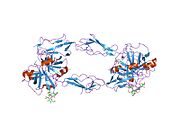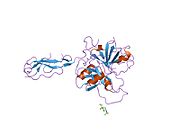Biology:Complement component 1r
From HandWiki
Short description: Protein-coding gene in humans
 Generic protein structure example |
Complement C1r subcomponent (EC 3.4.21.41, activated complement C1r, C overbar 1r esterase, C1r) is a protein involved in the complement system of the innate immune system.[1][2][3] In humans, C1r is encoded by the C1R gene.[4]
C1r along with C1q and C1s form the C1 complex, which is the first component of the serum complement system. C1r is an enzyme that activates C1s to its active form, by proteolytic cleavage.
Clinical significance
- Ehlers–Danlos syndrome Periodontal type is associated with mutations in the CR1 gene
Function
C1r has been shown to interact with C1s. C1r cleaves C1s to form the active form of C1s.[5][6]
References
- ↑ "The human complement system serine proteases and their proenzymes". Proteolytic Enzymes, Part C. Methods in Enzymology. 80 Pt C. 1981. pp. 26–42. doi:10.1016/s0076-6879(81)80006-7. ISBN 9780121819804.
- ↑ "Nucleotide sequence of the cDNA coding for human complement C1r". Biochemistry 25 (17): 4855–63. August 1986. doi:10.1021/bi00365a020. PMID 3021205.
- ↑ "Molecular organization and function of the complement system". Annual Review of Biochemistry 57: 321–47. 1988. doi:10.1146/annurev.bi.57.070188.001541. PMID 3052276.
- ↑ "Entrez Gene: C1R complement component 1, r subcomponent". https://www.ncbi.nlm.nih.gov/gene?Db=gene&Cmd=ShowDetailView&TermToSearch=715.
- ↑ "The N-terminal CUB-epidermal growth factor module pair of human complement protease C1r binds Ca2+ with high affinity and mediates Ca2+-dependent interaction with C1s". The Journal of Biological Chemistry 274 (14): 9149–59. April 1999. doi:10.1074/jbc.274.14.9149. PMID 10092586.
- ↑ "Interaction of C1q and mannan-binding lectin (MBL) with C1r, C1s, MBL-associated serine proteases 1 and 2, and the MBL-associated protein MAp19". Journal of Immunology 165 (2): 878–87. July 2000. doi:10.4049/jimmunol.165.2.878. PMID 10878362.
Further reading
- "Familial deficiency of two subunits of the first component of complement. C1r and C1s associated with a lupus erythematosus-like disease". Arthritis and Rheumatism 21 (8): 958–67. 1979. doi:10.1002/art.1780210813. PMID 737019.
- "A calcium-binding monoclonal antibody that recognizes a non-calcium-binding epitope in the short consensus repeat units (SCRs) of complement C1r". Molecular Immunology 29 (1): 83–93. January 1992. doi:10.1016/0161-5890(92)90160-Y. PMID 1370572.
- "Recombinant human complement subcomponent C1s lacking beta-hydroxyasparagine, sialic acid, and one of its two carbohydrate chains still reassembles with C1q and C1r to form a functional C1 complex". Biochemistry 31 (17): 4254–62. May 1992. doi:10.1021/bi00132a015. PMID 1533159.
- "NH2-terminal calcium-binding domain of human complement C1s- mediates the interaction of C1r- with C1q". Biochemistry 29 (19): 4613–8. May 1990. doi:10.1021/bi00471a016. PMID 2372546.
- "Genetic studies of low-abundance human plasma proteins. XI. Linkage analysis and population genetics of the C1S subcomponent of the first complement component". Complement and Inflammation 6 (2): 81–7. 1989. doi:10.1159/000463078. PMID 2541966.
- "Identification of erythro-beta-hydroxyasparagine in the EGF-like domain of human C1r". FEBS Letters 222 (1): 129–34. September 1987. doi:10.1016/0014-5793(87)80205-3. PMID 2820791.
- "Assignment of the complement serine protease genes C1r and C1s to chromosome 12 region 12p13". Human Genetics 78 (4): 363–8. April 1988. doi:10.1007/BF00291737. PMID 2834284.
- "Nucleotide sequence of the cDNA coding for human complement C1r". Biochemistry 25 (17): 4855–63. August 1986. doi:10.1021/bi00365a020. PMID 3021205.
- "Cloning and sequencing of full-length cDNA encoding the precursor of human complement component C1r". The Biochemical Journal 240 (3): 783–7. December 1986. doi:10.1042/bj2400783. PMID 3030286.
- "Complete amino acid sequence of the A chain of human complement-classical-pathway enzyme C1r". The Biochemical Journal 241 (3): 711–20. February 1987. doi:10.1042/bj2410711. PMID 3036070.
- "Fluid-phase interaction of C1 inhibitor (C1 Inh) and the subcomponents C1r and C1s of the first component of complement, C1". The Biochemical Journal 201 (1): 61–70. January 1982. doi:10.1042/bj2010061. PMID 6282262.
- "Complete amino acid sequence of the catalytic chain of human complement subcomponent C1-r". Biochemistry 22 (8): 1758–64. April 1983. doi:10.1021/bi00277a003. PMID 6303394.
- "Oligo-capping: a simple method to replace the cap structure of eukaryotic mRNAs with oligoribonucleotides". Gene 138 (1–2): 171–4. January 1994. doi:10.1016/0378-1119(94)90802-8. PMID 8125298.
- "A common amino acid polymorphism in complement component C1R". Human Molecular Genetics 3 (1): 217. January 1994. doi:10.1093/hmg/3.1.217-a. PMID 8162045.
- "Expression of the complement classical pathway by human glioma in culture. A model for complement expression by nerve cells". The Journal of Biological Chemistry 268 (33): 25068–74. November 1993. doi:10.1016/S0021-9258(19)74572-4. PMID 8227070.
- "Identification of a cryptic protein kinase CK2 phosphorylation site in human complement protease Clr, and its use to probe intramolecular interaction". FEBS Letters 386 (1): 15–20. May 1996. doi:10.1016/0014-5793(96)00403-6. PMID 8635594.
- "Synthesis of classical pathway complement components by chondrocytes". Immunology 88 (4): 648–56. August 1996. PMID 8881771.
- "Structure and assembly of the catalytic region of human complement protease C1r: a three-dimensional model based on chemical cross-linking and homology modeling". Biochemistry 36 (21): 6270–82. May 1997. doi:10.1021/bi962719i. PMID 9174342.
- "Construction and characterization of a full length-enriched and a 5'-end-enriched cDNA library". Gene 200 (1–2): 149–56. October 1997. doi:10.1016/S0378-1119(97)00411-3. PMID 9373149.
- "Solution structure of the epidermal growth factor (EGF)-like module of human complement protease C1r, an atypical member of the EGF family". Biochemistry 37 (5): 1204–14. February 1998. doi:10.1021/bi971851v. PMID 9477945.
External links
- Human C1R genome location and C1R gene details page in the UCSC Genome Browser.
- Complement+C1r at the US National Library of Medicine Medical Subject Headings (MeSH)
 |





